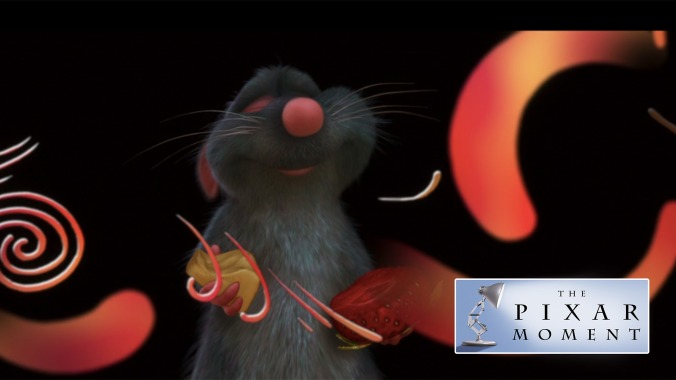Ratatouille tugs on taste buds, not heartstrings, and is all the better for it

Emile is a rat that eats trash. Emile, you see, is us.
But Emile, voiced by Peter Sohn, isn’t the central character of Brad Bird’s Ratatouille. That would be Remy (Patton Oswalt), a rodent who, unlike his furry brethren, is blessed with a sharp palate and a passion for food, flavor, and experimentation. After a flood lands him at the doorstep of Gusteau’s, his late hero’s now-failing restaurant, the pint-sized gourmand brings revival to the kitchen using a young “garbage boy,” Linguini (Lou Romano), as his vessel. In the end, it’s up to the duo to save Gusteau’s by pleasing an uppity food critic, Anton Ego (Peter O’Toole), which they accomplish not with tweezers and microgreens but with the hearty simplicity of the film’s namesake dish.
Ratatouille, it turns out, is a perfect name for Brad Bird’s 2007 feature, because the dish itself is what unifies both its plot and its themes. Remy’s ratatouille is both refined and approachable, humble and confident, flavorful and healthy—it is food suited for both the fastidious diner and the casual one.
And where Ego is one of the former, a man who’s come to view food as more art piece than experience, Emile is one of the latter. Emile, much like the rest of Remy’s rat clan, doesn’t consider what he eats so much as his need to eat. It doesn’t matter where a morsel comes from, it matters only that it is chewable and digestible. One imagines that for the average viewer—especially the average child viewer—Emile is something of an audience surrogate.
That’s why Ratatouille’s most resonant moments may be the ones that find Remy trying to show his brother why food is meant to be savored, not inhaled. The problem is that food’s sensory pleasures are difficult to manifest in words alone, as our hero learns when his “lightning-y” description does little to make Emile stop and think. Bird, acknowledging this limitation, opts for a different approach, using color, shape, and music to illustrate not only the joys of taste but of cooking itself.
In a move that buoys Bird’s reputation as one of animation’s boldest innovators, the director recruited composer Michael Giacchino and artist Michel Gagné for a sequence that would illustrate the sensation of synesthesia, the phenomenon by which senses merge and manifest in shapes and colors. Giacchino was “horrified” by the request at first, saying in a 2015 interview that the idea of interpreting taste via music “sounded so hard and ridiculous at once.” After considering the many variations of flavor, however, he came around. “Is it a ‘sharp’ taste? Is it a ‘round’ taste? Is it a ‘thin’ taste?” he said. “I ended up modeling the sound around those ideas.”
The result is one of the film’s most evocative scenes, with Remy visualizing the taste of a strawberry in graceful squiggles and strings, the taste of cheese with buoyant circles and percussion, and the taste of both together as an ecstatic, symphonic blend of the two. It’s a simple, ingenious utilization of a visual medium to convey the complexities of taste and flavor to viewers who perhaps never considered that food could be contextualized in such a way.
It’s also a deft illustration of the film’s overarching theme, which is that fussy chefs and overwrought critics aren’t culinary gatekeepers; anyone who wants to can throw on an apron, command their own kitchen, and begin developing their own culinary language. Early in his adventure, Remy doesn’t yet know how to discuss food, but after his fellow chefs serenade him with a good loaf of bread’s “symphony of crackle” and other such idioms, he’s able to translate the senses into words—soon, he’s lauding the “tangy” and “nutty” qualities of his own creations. Emile’s palate isn’t reformed by film’s end, but he’s at least eating slower, appreciating each chew a teensy bit more.
Pixar is rightfully celebrated for its ability to translate big emotions in palatable, kid-friendly ways, but Ratatouille’s focus on taste buds over heartstrings is what makes it such a singular entry in the studio’s canon. Food, after all, is one of the first constants a child encounters in life, and the sooner they learn that eating is more than just consuming, the better. They’ll be bingeing Top Chef in no time.